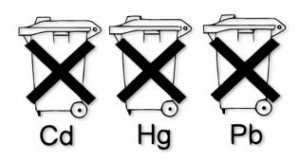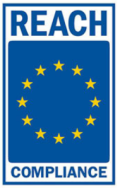REGULATIONS
Batteries and accumulators
EUROPEAN BATTERY DIRECTIVE
In Europe the main legislation that regulates batteries is the European Battery Directive (Directive 2006/66/EC) on batteries and accumulators and waste batteries and this has the aim of minimising the negative impact of batteries on the environment and improving their overall environmental performance.
This directive defines three classes of batteries (Portable, Industrial and Automotive) and it restricts the use of some materials in batteries (particularly mercury and cadmium in portable batteries). It also tasks Member States of the European Union with encouraging the development of improvements to the environmental performance of batteries and putting in place battery collection schemes. Member States must also ensure that storage and recycling of spent batteries is appropriate and fit for the purpose. Member States are required to regularly report on progress in the areas covered by this Directive. Under this directive SLI (starting, lighting, ignition) batteries are defined as automotive batteries whereas hybrid and electric vehicle batteries are treated as industrial batteries. Furthermore, the Battery Directive acts as a framework law, foreseeing further legislation in the field of batteries.
In addition this directive imposes labelling requirements on all battery types to encourage battery recycling and identify any heavy metals that may be contained within as shown opposite.

ROHS:
Restriction of Hazardous Substances in Electrical and Electronic Equipment
Batteries, accumulators and rechargeable batteries are not subject to the RoHS Directive; they are covered solely by EU Regulation 2023/1542.
The exclusion of batteries and accumulators from the RoHS Directive is specified in Article 2 (‘Scope’), paragraph 4, point e) of Directive 2011/65/EU (‘RoHS 2’), which explicitly states that ‘batteries and accumulators’ are excluded from the scope of RoHS.

REACH:
registration, Evaluation, Authorisation & Restriction of Chemicals
The following is a synopsis of the regulations contained within REACH:
- From 1st June 2008, manufacturers of substances, and importers of substances as such or of substances in preparations (mixtures) into the European Community (EC) and the European Economic Area (EEA), must register these substances with the European Chemicals Agency (ECHA) if the substances in question are manufactured or imported in quantities of at least 1 tonne per year and if they are not substances that are exempted from compulsory registration.
- Suppliers of substances and preparations must provide the recipient with either a safety data sheet (Article 31) or safety information (Article 32). In certain cases, the safety data sheet will be supplemented by an annex (“extended safety data sheet”) showing the relevant exposure scenarios.
- Manufacturers and importers of articles that contain more than 0.1 mass percent per article of a substance on the “candidate list” of Substances of Very High Concern (SVHC) shall provide the professional recipient and on request a consumer of the article with sufficient information to allow safe use of the article, including, as a minimum, the name of that substance.
Under the REACH regulations batteries are defined as an article. Enix Power Solutions supply articles (not substances or chemicals) which are not intended to release any substance under normal and reasonably foreseeable conditions of use. Consequently, the obligations in No. 1 and 2 above are not relevant to Enix Power Solutions. The first “candidate list” of SVHC’s was published on 28th October 2008 and is periodically updated.

CE Marking
This marking certifies that products comply with strict safety, durability, and environmental protection requirements.
To obtain the CE marking, it is mandatory to perform electromagnetic compatibility (EMC) testing in accordance with Directive CEM 2014/30/UE. These tests ensure that batteries do not generate harmful electromagnetic interference and that they withstand environmental electromagnetic disturbances.
Additionally, rechargeable batteries must be certified according to the international standards IEC62133 or IEC62619.
- The IEC62133 standard mainly applies to portable lithium-ion batteries, ensuring their electrical and chemical safety under normal use and foreseeable misuse.
- The IEC62619 standard targets batteries used in industrial and stationary applications, including industrial vehicles, AGV, and storage systems, with enhanced tests against internal short circuits and thermal propagation.
Thus, CE marking compliant with Regulation 2023/1542, combined with EMC testing and IEC certification, guarantees that cells, accumulators, and batteries marketed in Europe are safe, reliable, and environmentally friendly. CE marking becomes a strategic lever to ensure regulatory compliance and consumer confidence.
UKCA MARKING
Since May 2024, the UK government has reauthorized the use of CE marking for many products, including cells, batteries, and accumulators, for marketing on the UK market as an alternative to the UKCA marking.

Transport of Dangerous Goods
- Lead-acid batteries: Common in cars, electric wheelchairs, some continuous computer power sources, and other applications. These batteries contain highly corrosive acid and can cause fires from short circuits. Tested, proven non-spillable batteries are allowed under international rules to be shipped as non-hazardous if they will not leak from a cracked case at a high temperature. Batteries and packagings may also be marked “NONSPILLABLE” or “NONSPILLABLE BATTERY”.
- Lithium-metal and lithium-ion batteries: These batteries can be rechargeable or non-rechargeable power sources and are common in computers, cell phones, cameras, and other small electronic devices. If dropped, crushed, or short-circuited, lithium batteries can release dangerous amounts of heat and may ignite, making them dangerous in fires. Special regulations apply to shipping these batteries. Shipments requiring dangerous goods shipping documents are accepted only from approved shippers by most air transport carriers.











